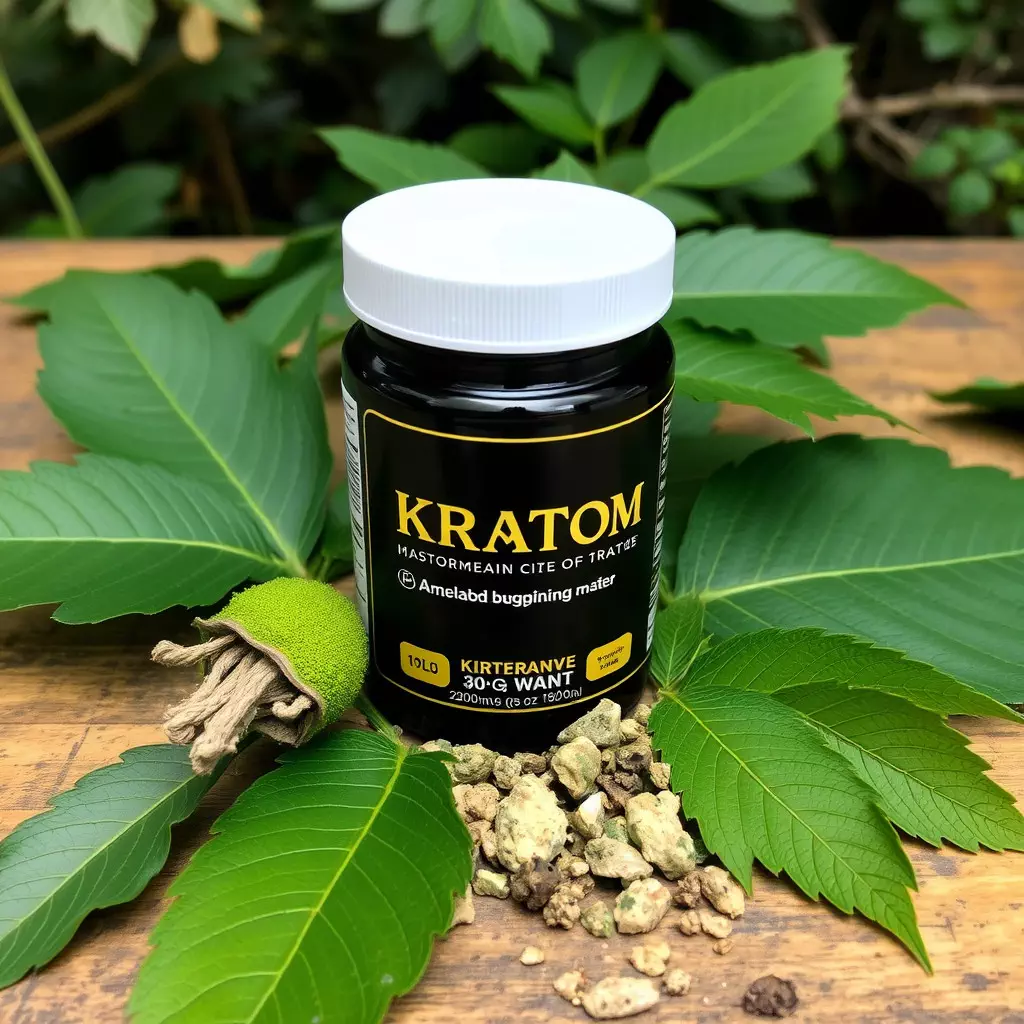Kratom, derived from the Mitragyna speciosa tree in Southeast Asia, has been recognized for its potential to alleviate joint pain and muscle soreness. Its efficacy is attributed to the active compounds mitragynine and 7-hydroxymitragynine, which engage with opioid receptors, offering a natural analgesic effect. The benefits of kratom can be fine-tuned through dosage and strain selection, providing both stimulating and sedative effects to meet individual needs for pain management. It's a potential alternative to traditional pain medication, particularly for those with conditions like fibromyalgia and arthritis. However, its use should be approached with caution due to varying legal statuses by jurisdiction and the necessity of medical advice before consumption. Kratom's interaction with mitochondria in neuronal cells may play a role in modulating pain signals and its anti-inflammatory properties are under investigation for joint pain relief. Safety is crucial, as kratom can cause side effects at higher doses and there is a risk of dependence or addiction. It's not suitable for everyone, including pregnant or breastfeeding women, minors, and those with pre-existing health conditions. Always consult healthcare professionals to determine the suitability of kratom in your pain management plan and to navigate potential interactions with other treatments.
Muscle and joint soreness can be a significant hindrance to daily activities, often stemming from intense workouts, occupational strain, or aging. Many individuals seek natural remedies to alleviate this discomfort without the side effects associated with traditional pain medication. Enter kratom, a botanical substance that has garnered attention for its potential analgesic properties. This article delves into how kratom may offer relief for muscle and joint pain, shedding light on its mechanisms through scientific evidence, guiding readers on optimal dosage, and addressing safety considerations for those exploring kratom as a natural pain management solution. Understanding the nuances of kratom’s role in alleviating soreness is crucial for those looking to mitigate joint pain relief with kratom effectively and responsibly.
- Understanding Kratom's Role in Alleviating Muscle and Joint Pain
- The Science Behind Kratom's Analgesic Properties for Soreness Relief
- Effective Dosage and Safety Considerations When Using Kratom for Pain Management
Understanding Kratom's Role in Alleviating Muscle and Joint Pain

Kratom, a tropical evergreen tree native to Southeast Asia, has garnered attention for its potential pain-relieving properties, particularly in the context of muscle and joint soreness. The active compounds found in kratom leaves, namely mitragynine and 7-hydroxymitragynine, interact with the body’s opioid receptors, offering a natural approach to pain management. Users report that kratom helps alleviate chronic pain, including muscle and joint discomfort, by influencing the brain’s interpretation of pain signals. The effects are often described as both stimulating and sedative, depending on the dosage and strain used, allowing individuals to find a balance that suits their specific needs. For those experiencing soreness from intense physical activity or suffering from conditions like fibromyalgia or arthritis, kratom may provide a degree of relief without the side effects commonly associated with prescription pain medications. However, it’s important for potential users to approach its use with caution and consider consulting healthcare professionals, especially given the regulatory status of kratom in various countries and states.
The Science Behind Kratom's Analgesic Properties for Soreness Relief

MITOCHONDRIAL INFLUENCE AND PAIN REGULATION: Kratom, a tropical plant from Southeast Asia, has been traditionally used for its medicinal properties, including pain relief. The analgesic effects of kratom are thought to stem from its interaction with the body’s opioid receptors, as well as its influence on neurotransmitter systems such as serotonin and norepinephrine. At the cellular level, kratom alkaloids like mitragynine and 7-hydroxymitragynine are believed to modulate pain signals by binding to ion channels in the mitochondria of neuronal cells, which can lead to reduced pain perception. This mechanism offers a potential explanation for kratom’s effectiveness in providing joint pain relief and muscle soreness alleviation. Users often report that kratom helps manage their discomfort, potentially due to its unique interaction with the body’s pain response pathways.
BIOCHEMICAL EFFECTS AND MUSCLE SORENESS RELIEF: The analgesic properties of kratom are further supported by its influence on mu, delta, and kappa opioid receptors, which play a significant role in pain modulation. In the context of muscle soreness, such as that experienced after intense physical activity, kratom may offer relief through its action on these receptors. Moreover, the anti-inflammatory effects of kratom are being studied for their potential to reduce inflammation associated with joint and muscle pain. The combination of its analgesic and anti-inflammatory actions could make kratom a valuable supplement for those seeking natural alternatives to manage soreness. However, it is crucial for individuals to consult healthcare professionals before incorporating kratom into their pain management regimen, given the complexity of individual responses to such substances and the need for proper dosing and monitoring.
Effective Dosage and Safety Considerations When Using Kratom for Pain Management

When exploring the use of kratom for muscle and joint pain relief, it’s crucial to determine an effective dosage that balances the desired therapeutic effects with safety considerations. Kratom, derived from the leaves of Mitragyna speciosa, has been traditionally used in Southeast Asia for its analgesic properties. For pain management, including muscle soreness, users often start with a low to moderate dose, typically ranging from 2 to 5 grams. This dosage can provide relief for mild to moderate discomfort without the need for more potent pharmaceuticals. However, individual tolerance and pain severity can influence the optimal dosage; therefore, it’s important to approach any kratom regimen with caution and adapt based on personal response.
It’s equally important to consider safety when using kratom. The substance can interact with certain medications and may have side effects such as nausea, constipation, and drowsiness at higher doses. Long-term use can lead to dependence or addiction in some individuals. Therefore, users should adhere to recommended guidelines, which include not exceeding a daily dosage of 5 grams and avoiding combining kratom with other substances unless under the guidance of a healthcare professional. Additionally, those with pre-existing health conditions, pregnant or breastfeeding individuals, and minors should avoid kratom altogether due to potential risks. Always consult with a healthcare provider before incorporating kratom into a pain management plan to ensure it is appropriate for your specific circumstances and to discuss any potential interactions with other treatments you may be undergoing.
Muscle and joint soreness can significantly impede daily activities, often necessitating effective relief solutions. The exploration of kratom’s role in mitigating such discomfort has revealed promising insights into its analgesic properties. Understanding the science behind kratom’s impact on pain alleviation underscores its potential as a natural alternative for those seeking soreness relief. While effective dosage and safety remain paramount for responsible use, the findings suggest that kratom may offer substantial benefits in joint pain relief with kratom when used appropriately. As with any pain management strategy, consulting healthcare professionals is essential to ensure safe and effective treatment options tailored to individual needs. With further research, kratom’s potential as a natural remedy for muscle and joint soreness continues to be an area of significant interest and could pave the way for innovative approaches in pain management.






